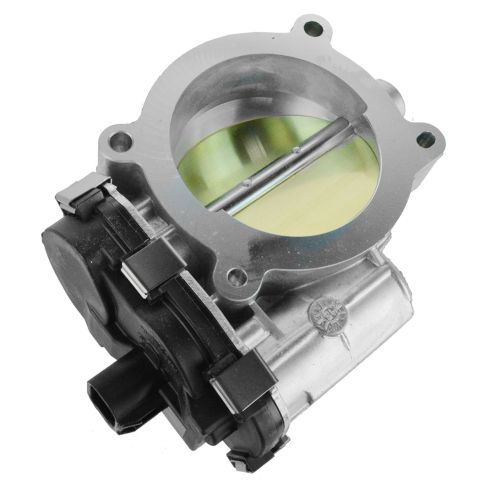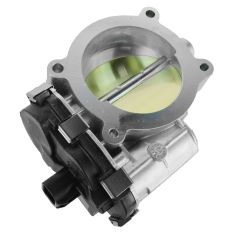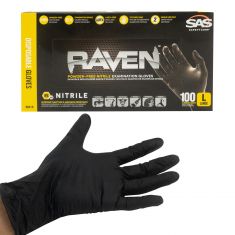1ATBA00007-Throttle Body Assembly TRQ TBA07513
Replaces
2008 GMC Savana 1500 Van V8 5.3L Throttle Body Assembly TRQ TBA07513
Frequently bought together
Product Reviews
Loading reviews
4.83/ 5.0
42
42 reviews
Worked Perfect BUT......
August 29, 2017
Simple change out, pulled info online for the relearn procedure:
Heres the throttle body relearn procedure
1) Start the engine and let it idle in park for 3 minutes. During that period the idle may be higher idle than normal.
2) After 3 minutes, turn the engine off and leave it off for 60- seconds.
3) Start the engine again and let it idle in park for 3 minutes one more time. During these run periods you may see a check engine light. Scan for codes and if you get throttle body related codes, clear them.
4) If the idle speed is still off, drive the vehicle at speeds above 44-mph and operate several acceleration and deceleration cycles. Then repeat step #3 one last time.
The idle should now be normal
My fuel economy has improved from 12-14 mpg to 16.5-18 mpg. Can't beat that!
My only complaint, I paid $97.95, and now that I've been prompted to leave a review, the price is $84.95. So I paid $13 more!
Good Product Though.
Quick and easy
September 28, 2017
Quick, easy, works great and great customer service
Its an OEM fit
October 12, 2017
It took me 10 minutes to swap out and fit perfectly. Of course there were other issues with the computer but the throttle body itself is great. Gotta love putting new parts on.
SO FAR SO GOOD
November 30, 2017
WE ARE SO PLEASED THAT 1AAUTO HAD THIS PART FOR OUR TRUCK IT WORKS AND WAS VERY EASY TO IN STALLED TOOK LESS THAN FIFTEEN MINS TO DO BUT NOW WE HAVE TO HAVE OUR COMPUTER RE CALIBRATED TO THE NEW ONE OUR RPMS WENT SO HIGH AFTER WE PUT THIS PART ON SO NOW WE HAVE TO SEE THE DEALER AND THAT WILL POSSIBLY BE MORE MONEY OUT FOR THEM TO DO THIS
OTHER THAN THAT WE WILL CONTINUE TO SHOP AT 1AAUTO FOR OUR TRUCK PARTS
THANKYOU 1A AUTO
WE KNOW OUR TRUCK THANKS U TOO
Everything was great!!!
December 23, 2017
I love A1 Auto the part came quickly and was exactly what I needed.
Very good product
February 26, 2018
This throttle body is really good. Works perfectly fine no complaints
perfect deal
April 25, 2018
ok straight to the point, so i only had to do the relearn procedure 4 times and those 4 times
i started truck 1 min then turn off 1 min,
turn on truck 3 min turn off 3min, IMPORTANT do not
accelerate or touch pedal while doing first idle checks and when put on drive it will accelerate by it self but just make sure you go from park to drive fast before rpm goes up so it dont kick then turn truck on again and drive for about 10-15min trying to stay on about 44mph as most possible, ALSO once you are ready to shift back to park or reverse or neutral make sure you just hold brake in drive until rpm goes down about 5-10seconds... after 3rd time i notice the change and then 4th fixed in a period of about 1 week. i love how fast 1aauto ship it! definitely will buy more items!
May 18, 2018
ordering was easy delivery was early and the part works like it should. very happy
Great part
June 8, 2018
Great part
Quick service
No shipping
Perfect fit ---- bolt on
Throttle body and sensor for a 07 Chevy Tahoe
July 5, 2018
Order a throttle body and sensor. It was a perfect match . easy to put in with with the video. That take no more than 20 minutes and delivery was right on time.
Gm throttle body
October 23, 2018
Direct fit bolted right up. 15 min repair trucks running great So far, seemed to be good quality for the price. Would buy again.
Great product
December 13, 2018
Great product! Works great and easy install. How to videos by 1A-Auto are perfect!
A1auto thank you
February 17, 2019
Days after looking for the right part for my truck i always found it to expensive so I decided to check it out in A1auto and found it for less so I bought it it was delivered a day before for wat I was expecting that same day I check it out and it was The same original part I installed it and in minutes for check engine disappeared thank you for selling quality parts For less
Perfecto
February 27, 2019
The throttle body I ordered was at my door within 3 days. Not bad for FREE shipping!! The new assembly fit perfectly and was very easy to install. I was able to watch a quick instructional video just to prepare and there was nothing to it. Always pleased with 1a and will always use them for my trucks lifetime!!
March 1, 2019
So Far so Good. Easy install.
Throttle body
March 20, 2019
Thanks for the great part took care of the problem. And awesome price I will be buy more parts from
You for sure thanks again jack
Cheaper price than other places
March 21, 2019
I haven't installed it yet but I will most likely this week the part arrived
On earlier than expected . Part looks to be pretty solid and well made.
throttle body
March 25, 2019
this throttle body is exactly what we needed to fix one of our older vehicles in the fleet. the install and "programming" was seamless. i will buy this product again if the need arises.
April 11, 2019
100% satisfied
October 9, 2019
Part fit perfectly for the vehicle
December 11, 2019
Great part works great.
Worked out well for me
December 28, 2019
Came very well packaged and arrived very fast. Clean and works great
Good
January 6, 2020
Worked excelent and i got a better deal on the part since auto zone was way more expensive. Always order here first.
Throttle body
January 10, 2020
Exact fit. Easy install. Video for installation and relearn.
Great price
January 13, 2020
Part bolted up perfectly, with no performance issues. Great quality for much less than the rest.
Throttle body
April 21, 2020
New throttle body worked perfect, no issues with install and no relearn was necessary. excellent product and arrived just as promised. Thanks
So Far, Good
April 21, 2020
I purchased this new throttle body, mainly because it was about the same price as one rebuilt from a parts store. Since it's been installed, my truck is running very well and I've noticed a difference in how the truck runs pulling the ministry trailer. I am very pleased with this part.
What a difference.
May 7, 2020
What a difference it made replacing the throttle body responsive gets up and goes when u need it. Faulty sensor from the originalt throttle body in my 2007 chevy tahoe. If you are having problems on how the vehicle respond change the throttle body makes a difference.
15 min install - no relearn
September 13, 2020
I replaced this throttle body on my 2006 Buick Rainier because the Stabilitrack warning kept coming on and the engine would derate. As an added benefit, it fixed a rough shift issue which I thought was a transmission problem. I was going to spend the extra money to get an OEM AC Delco but I have learned to trust 1A Auto when it comes to parts for my Rainier. These guys are really dialed in to the GM 360 platform so I get all my parts here.
Relearn my be required
November 11, 2020
Ordered this for my 2008 GMC Sierra. Part came quickly and the install was a snap. It cured all my rough idle and hesitation issues but my idle was higher and sometimes the engine would rev up and not come down, like the throttle was sticking. I tried unhooking the battery and every other computer reset I could find on the web, but they either didn't work or only worked for a short time. After my truck stuck at 3000 rpms and put me in a tough situation on the interstate I had to take it to the shop. A 10 minute relearn on my ECM had my truck running perfect. There was nothing wrong with the part, I have nothing bad to say about the part I just wished it came with literature explaining that a relearn may be necessary and to test drive your vechile in short distances before trusting it for the road.
Awesome fixed my problem
February 17, 2021
Truck was going into limp mode and dying Changed and runs like a new one
Part failed in three months
May 31, 2021
I purchased a throttle body for my chevy on 02/23/21 for my chevy. It failed on Memorial Day ,while travelling to the lake for a picnic. Worst auto part purchase that I have ever experienced. Will never make another purchase from this company. Will buy from auto zone from this point on. Pulling the part off the vehicle and shipping it back is to much trouble. Especially if your dealing with cheap low quality parts like this company sells.
October 20, 2021
A perfect plug and play!
November 16, 2021
I love it but do you have to program the truck computer when you install it
Great product!!!
December 30, 2021
Anyone that complains about this throttle body. Must have gotten a factory defect one.. car runs great again after replacing. Also didn't have to program anything. Plug and play. Also seems like I'm using a little less ?
January 31, 2022
AWESOME POWER AND MILEAGE AGAIN
March 9, 2022
Works well
EZ
May 4, 2022
this install was ez. changing a spare tire is much more laboring. watch the video, and you will have no problem
February 29, 2024
Works good and looks good
Oem
May 18, 2024
Made my truck feel new from the motor oem part quick response when I accelerate
June 20, 2024
The first one was bad. They immediately sent me on a second one. It works great.
August 13, 2024
Direct fit easy install
Customer Q&A
Does it come with a new gasket?
January 30, 2018
10
No mine didn't. Gasket is on intake Manifold
January 30, 2018
DANIEL G
10
It does come with a gasket.
January 30, 2018
Leon H
What is the size? (mm)
November 27, 2018
10
Actual Measurements are not listed or available. Our parts are exact replacements for your vehicle's OEM parts.
As long as your year, make, and model match up with our listing, these parts will directly fit and function like the originals.
November 27, 2018
Christa R
does this need to be programmed or is it ready to roll?
January 10, 2019
10
Yes the GM throttle body will need a relearn procedure completed after installation. An good scantool will make this job easier.
January 10, 2019
Terrance M
10
Needs programming
January 10, 2019
John A
10
There is no necessary reprogramming after installation. However, you will need a scan tool to test for proper throttle-opening and throttle-closing range.
January 10, 2019
Jessica D
10
It does need to be. There is a manual way to do. You can look it up or just take it to a shop and have them reprogram it. There are several steps when doing it manually.
January 17, 2019
M A
Will this fix a 2007 Silverado intimidator??
February 28, 2019
10
This part is specific to vehicles with a particular set of options. We will need more information about your vehicle to confirm the fit. Please give us a call and we will be happy to help you out.
February 28, 2019
Adam G
Does this fit a 2007 GMC Sierra SLT 6.0?
October 6, 2019
10
Thank you for your inquiry. This will be the correct fit for that vehicle and engine size. Please let us know if you have any further questions.
October 6, 2019
A C
Does it need to be relearned ??
January 25, 2020
10
Thank you for the inquiry. There is no necessary reprogramming after installation. However, you will need a scan tool to test for proper throttle-opening and throttle-closing range.
January 25, 2020
Curtis L
Does it come with a gasket or does it not I see two different answers?
July 29, 2020
10
Thank you for your inquiry, Stephen! No this part does not come with a new gasket.
July 29, 2020
T I
What mm boar is it?
October 2, 2020
10
Thank you for your inquiry. These specifications are not listed or available. Our parts are exact replacements for your vehicle's OEM parts. As long as your year, make, and model match up with our listing, these parts will directly fit and function like the originals. Please let us know if you have any other questions. Thank you!.
October 2, 2020
Jessica D
Does the gasket come with the part ?
July 12, 2021
10
The gasket will not be include with the throttle position assembly.
July 13, 2021
Emma F
All lights flicker 20011chevy avalanche ?
November 30, 2021
10
I chased that for 2 years. Replaced most everything. Nothing helped. I kept telling me it was the antiskid. Last thing was plug wires. @250k purrs nicely. I don't think it's the wires though. Fuel pump seemed to make the most difference. Much$$$. Last bowtie for me!
November 30, 2021
Dick B
10
Probably not throttle body
November 30, 2021
Marlin C
10
There could be multiple reasons why you're having this particular problem. We suggest taking your vehicle to a nearby reputable shop to identify the cause. Once you know the cause, we'll be happy to see if we carry the parts and how-to videos needed for your repair.
December 1, 2021
Adam G
hello was wondering can this be my cause of my Engine just shutting off at idle ?? only does it at low rpm speeds Have noticed the RPM rev up little bit than it will shut off? I have been in a stop light it has shut off on us bunch of times This can
February 13, 2022
10
There could be multiple reasons why you're having this particular problem. We suggest taking your vehicle to a nearby reputable shop to identify the cause. Once you know the cause, we'll be happy to see if we carry the parts and how-to videos needed for your repair.
February 14, 2022
T I
What do the fuel pump manual do for a truck?
October 17, 2022
10
Had to replace my throttle body two months after putting in 1A autos didnt feel like messing with the warranty so I just bought a a/c delco and no issues since
October 18, 2022
Heath S
10
This is an electronic throttle body. It mounts on the intake manifold and regulates acceleration speed.
October 18, 2022
Jason R
WHY DOESN'T THE PARTS COME WITH GASKETS--???????????????
November 5, 2022
10
The vendor does not include the gaskets with this part. You should be able to purchase that locally.
November 5, 2022
Kelly S
Does this fit the 2008 gmc yukon xl denali with the 6.2l?
March 22, 2023
10
Yes, this part will fit your vehicle.
March 23, 2023
Jessica D
GMC is a registered trademark of General Motors Company. 1A Auto is not affiliated with or sponsored by GMC or General Motors Company.
See all trademarks.














